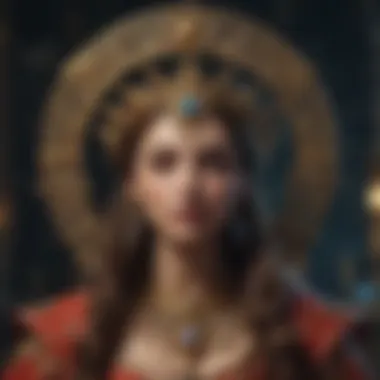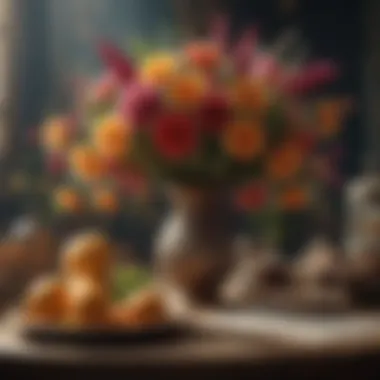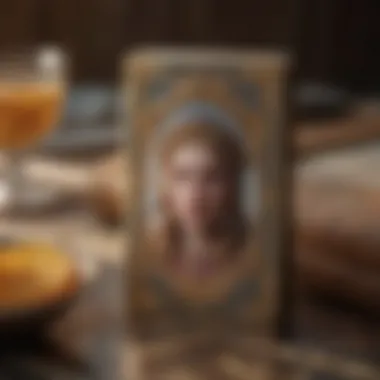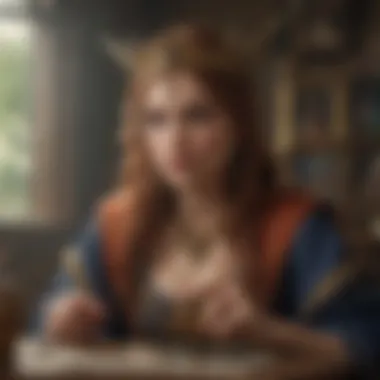Exploring the Most Beautiful Tarot Decks of 2021


Intro
In recent years, the tarot community has seen a resurgence in interest and creativity. With numerous decks hitting the market, 2021 stood out as a year for beautifully crafted tarot decks. This article aims to dissect the most visually appealing options, focusing on their artistic elements, underlying themes, and how these designs influence tarot practice. Whether you are a seasoned tarot reader or a curious collector, understanding the nuances of these decks will enhance your tarot journey.
Through careful analysis, we will guide you in selecting a tarot deck that resonates with your individual aesthetic and practical needs. The combination of art and functionality in tarot decks adds layers to readings, making this exploration both rewarding and enriching for astrological practitioners.
Understanding the Zodiac
Many tarot decks draw inspiration from the rich tapestry of astrology. Understanding the Zodiac provides insight into the symbolic language often present in tarot imagery.
Overview of Zodiac Signs
The Zodiac is composed of twelve signs, each with its unique characteristics and qualities. From Aries to Pisces, these signs influence various aspects of life and provide a framework for interpreting tarot cards.
Sign Traits and Characteristics
- Aries: Bold and adventurous, known for their leadership.
- Taurus: Grounded and reliable, focused on material values.
- Gemini: Social and inquisitive, masters of communication.
- Cancer: Intuitive and caring, deeply connected to emotions.
- Leo: Charismatic and confident, natural performers.
- Virgo: Detail-oriented and analytical, strives for perfection.
- Libra: Diplomatic and fair-minded, values relationships.
- Scorpio: Passionate and mysterious, transformative in nature.
- Sagittarius: Philosophical and freedom-loving, seekers of truth.
- Capricorn: Responsible and disciplined, focused on achieving goals.
- Aquarius: Innovative and idealistic, champions of change.
- Pisces: Compassionate and dreamy, deeply creative.
Elemental Qualities
Each Zodiac sign is associated with one of the four elements: Fire, Earth, Air, and Water. This elemental connection influences the overall theme of many tarot decks. For instance, a deck celebrating Water might evoke imagery related to intuition and emotion.
By understanding these traits and elemental qualities, tarot readers can better interpret the messages conveyed by various decks. This understanding also aids in selecting a deck that resonates with one’s astrological identity or preferred elemental connections.
Astrological Insights
Astrology not only enriches our understanding of tarot but also provides insights into current celestial influences that affect our lives.
Current Astrological Trends
Tracking the movement of planets and astrological events reveals significant trends. For example, retrogrades can bring about introspection and reevaluation in tarot readings, depending on the cards drawn.
Influence of Celestial Events
Lunar phases, solar eclipses, and planetary alignments create powerful energies that can enhance or challenge our tarot practices. Recognizing these influences helps practitioners align their readings with the cosmic flow.
How to Interpret Your Birth Chart
A birth chart offers an astrological snapshot at the moment of your birth. Integrating this knowledge with tarot readings allows for deeper self-reflection and personalized insights. Understanding your Sun, Moon, and rising signs can inform which tarot decks may resonate most strongly with your inner self.
Horoscope and Predictions
Enhancing tarot reading with horoscopic understanding can elevate one's practice. Tarot enthusiasts often incorporate astrological predictions into their readings.
Monthly or Weekly Forecasts
Creating forecasts using tarot cards alongside horoscopes can provide clarity about upcoming challenges and opportunities.
Personalized Horoscope Reading
Using tarot to explore personalized readings based on zodiac signs deepens the connection between the cards and the querent's astrological makeup.
Compatibility Readings based on Zodiac signs
Many tarot readers offer compatibility readings, examining relationships through the lens of both tarot and astrology. Understanding the dynamic interplay between different zodiac signs can reveal strengths and areas for growth.
“The synergy of tarot and astrology forms a powerful tool for introspection, guidance, and understanding.”
This article thus serves as both an exploration of the compelling art of tarot decks released in 2021 and a guide. Through blending knowledge of the Zodiac and astrological insights with tarot practice, readers can make more informed, meaningful choices as they navigate their tarot journeys.
Intro to Tarot Decks
Tarot decks have served a crucial role in various esoteric practices and personal explorations. They are not mere tools for divination but rather intricate artistic expressions that encapsulate human emotion and thought. This section introduces tarot decks by examining their aesthetic significance and structural composition. By understanding these elements, practitioners can better appreciate the choices they make when selecting a deck.


The Significance of Visual Appeal
Visual appeal in tarot decks extends beyond mere beauty. It plays an essential role in how readers connect with their tools. A well-designed deck can evoke specific feelings and provide clarity in readings. The imagery allows users to engage their intuition and emotional responses more deeply. This synergy between the art and the user enhances the entire tarot experience.
- Beautiful tarot decks can facilitate:
- Emotional connections to the cards.
- Deeper insights during readings.
- A more inviting atmosphere for both the reader and the querent.
A stunning deck can be more than aesthetically pleasing; it should resonate on a personal level, creating a bridge between the spiritual and the artistic.
Understanding Tarot Deck Composition
The composition of a tarot deck encompasses its structure, symbols, and the relationship between the cards. Each deck consists usually of 78 cards, divided into the Major and Minor Arcana. Understanding this structure is vital for interpreting the cards' meanings. Each card holds rich symbolism and function within the deck's narrative.
Key components of tarot deck composition include:
- Major Arcana: Represents significant life events and spiritual lessons.
- Minor Arcana: Focuses on everyday events, divided into four suits.
- Court Cards: Portray different personality traits and roles.
The thoughtful arrangement of art and symbolism fosters intuitive connections, enabling readers to channel their insights effectively. By grasping this composition, users enhance their understanding of not just the artwork, but the tarot's rich history and the meanings behind each card.
Criteria for Beauty in Tarot Decks
The significance of beauty in tarot decks extends beyond mere aesthetics. A well-designed deck can enhance the user's experience, deepen one’s connection to the cards, and even facilitate a more intuitive reading process. In this section, the focus will be on the specific elements that contribute to the perceived beauty of tarot decks. By understanding these criteria, readers can make informed decisions when selecting a tarot deck that resonates with their personal and spiritual practices.
Artistic Style and Technique
Artistic style serves as the foundation for a tarot deck's visual identity. Different artists employ various styles, which can range from traditional to contemporary. For instance, classical decks like the Rider-Waite-Smith utilize detailed illustrations and distinct symbolism. In contrast, modern decks like the Dreaming Way Tarot reflect a more whimsical and abstract approach.
Techniques also vary. Some decks are hand-painted, creating a unique texture and character, while others use digital methods for crisp and vibrant imagery. Both styles possess their own merits. A hand-painted deck may evoke a sense of warmth and authenticity, whereas a digitally crafted one could offer precision and vibrancy.
Considerations:
- Skill of the Artist: The artist's mastery of the chosen style can significantly influence the deck's appeal.
- Color Palette: Colors impact mood and interpretation. Softer hues may convey serenity, while bold colors can evoke excitement or urgency.
- Visual Clarity: Good design ensures essential symbols are recognizable and interpretable, enhancing usability during readings.
Symbolism and Imagery
Symbolism stands at the core of tarot. Each card tells a story through images that convey meaning. A deck rich in symbolism allows for deeper insights and connections. For example, the Thoth Tarot incorporates Kabbalistic ideas and astrological elements, making each image multi-layered and profound.
Imagery must also align with the themes of the deck. For decks inspired by nature, illustrations might feature flora and fauna, providing a harmonious blend of art and meaning. In contrast, decks that focus on mysticism may include abstract or surreal depictions, which invite unique interpretations.
Key Considerations:
- Cultural Relevance: Imagery that resonates with the intended audience can deepen the reading experience.
- Layered Interpretations: Cards that offer multiple layers of meaning can engage practitioners at various levels.
- Personal Resonance: Imagery that evokes personal emotions or memories can enhance connection during readings.
Thematic Consistency
Thematic consistency refers to the unity of ideas that permeate the entire deck. It determines how each card relates to the others, forming a cohesive narrative. A well-structured deck should maintain clarity while varying individual card meanings. For instance, the Shadowscapes Tarot blends fantasy art with classic symbolism, creating a unified theme that tells a story across all 78 cards.
Inconsistent themes can lead to confusion, making readings less effective. Practitioners may find themselves struggling to connect cards drawn together, resulting in a fragmented experience.
Considerations for Themes:
- Alignment with Purpose: The theme should align with the intended use of the deck, whether for divination, meditation, or personal growth.
- Narrative Flow: Cards in the same suits should relate to one another meaningfully, offering a sense of progression.
- User Interpretation: A consistent theme allows users to develop their personal interpretations, enriching their practice over time.
To summarize, the criteria for beauty in tarot decks encompass artistic style, symbolism, imagery, and thematic consistency. Each factor plays a vital role in overall perception and usage, deepening connections with the materials and enriching the reading experience.
Overview of Notable Decks from
The exploration of notable tarot decks released in 2021 provides a lens through which to view the evolving aesthetics and functionalities within this art form. Each deck contributes uniquely to the tarot landscape, often intertwining artistic vision with historical traditions. The significant aspect of these decks lies in their ability to resonate with users on multiple levels—visually, emotionally, and spiritually. Understanding the nuanced features of these decks equips practitioners and collectors alike with the knowledge needed to make informed choices.
By examining individual decks, one can appreciate the diversity of art styles and themes present during this particular year. This overview is not just about beauty; it encompasses how these decks are likely to influence practice, interpretation, and connection with the tarot itself. The consideration of their audience further enhances their significance, as recognizing the target users allows for deeper appreciation of how these decks might impact learning and experiences in tarot reading.
Deck One: The Wild Unknown Tarot
Artistic Overview


The Wild Unknown Tarot captivates with its hand-drawn illustrations that evoke a sense of intimacy and individuality. Created by Kim Krans, this deck is a blend of natural imagery and abstract elements, reflecting the interconnectedness of all living things. The use of ink and watercolor gives it a unique texture, which stands out from traditional decks. This artistic choice fosters emotional connections for those who seek a more personal tarot experience.
Its unique feature lies in its minimalistic yet expressive style, which is both an advantage and a disadvantage. While the simplicity allows for broad interpretation, the abstract nature might challenge some users who prefer more literal imagery in their readings.
Key Themes
This deck explores themes of nature, introspection, and transformation. The imagery often draws from natural archetypes, inviting users to reflect on the cycles of life and their own growth. It encourages a journey into the self, making it popular among those who wish to foster a deeper understanding of their inner workings.
The downside of its thematic focus might be that some users find it lacks a broader narrative that more traditional decks offer, potentially limiting its appeal among those who seek structured guidance.
Target Audience
The Wild Unknown Tarot resonates particularly with beginners and those interested in intuitive reading approaches. It presents an accessible pathway for users who may feel overwhelmed by more complex decks. However, its unconventional style might not cater to everyone, especially traditionalists who appreciate the classic archetypes depicted in standard tarot sets.
Deck Two: Tarot of the Divine
Artistic Overview
Tarot of the Divine, illustrated by Yoshi Yoshitani, combines a modern aesthetic with folklore from around the world. The vibrant colors and intricate designs are visually striking, creating a sense of wonder. Its narrative enhances the card meanings, giving users multiple layers of understanding with each draw.
This deck's unique feature is its storytelling aspect, which encourages users to explore various cultural narratives. While this can enrich the reading experience, some may find the varied symbols challenging to interpret without prior knowledge of the referenced cultures.
Key Themes
This deck weaves themes of mythology, unity, and magic throughout, promoting inclusivity and representation. By featuring stories from diverse cultures, it invites users to explore different perspectives and embrace a broader view of the human experience. This inclusivity is an appealing attribute, though it can demand a steep learning curve for those unfamiliar with the symbols presented.
Target Audience
Tarot of the Divine is geared towards those looking for a culturally rich tarot experience. It caters to both beginners and seasoned readers seeking to deepen their understanding of universally shared themes. The challenge, however, lies in the necessity for a sound foundation in tarot to fully appreciate the multi-layered messages.
Deck Three: The Light Seer's Tarot
Artistic Overview
The Light Seer's Tarot, created by Chris-Anne, merges modern art with traditional tarot symbolism. Its colorful and expressive style resonates with many, providing an uplifting and accessible approach. Each card embraces a contemporary vibe while respecting the classic tarot structure, making it visually appealing.
The unique feature of this deck is its optimistic and encouraging imagery, which is beneficial for users seeking positive affirmations through their readings. However, critics may argue that this positivity could lead to oversimplifications of complex issues that tarot often addresses.
Key Themes
Themes of healing, self-discovery, and empowerment permeate this deck. It encourages users to focus on personal growth and resilience, appealing to those in search of uplifting guidance. Yet, its strong emphasis on positivity may not resonate with users preferring a more balanced approach to interpretation.
Target Audience
This deck attracts a wide audience, including those new to tarot and those looking for a more dynamic reading experience. It is particularly favored by individuals seeking motivation and inspiration. Nonetheless, it may not suit practitioners who prefer a more serious or traditional approach to tarot readings.
The diversity found in the tarot decks of 2021 not only highlights the artistic creativity of the creators but also reflects the evolving needs of practitioners looking for connection and meaning in their readings.
Comparative Analysis of Selected Decks
The comparative analysis of tarot decks allows practitioners to evaluate the diverse artistic interpretations and symbolic meanings they present. This section provides an essential framework for understanding how each deck stands out in terms of visual composition and thematic richness. Through careful examination, readers can identify which decks resonate most with their personal tarot journey.
Artistic Comparisons
When analyzing different tarot decks, the artistic style plays a crucial role in defining their aesthetic appeal. Various artists employ distinct techniques, such as watercolor painting, digital illustration, or collage. Each method leaves its mark on the deck’s overall mood and energy.
For instance, the Moonchild Tarot utilizes a soft, ethereal art style, enhancing its mystical themes. In contrast, the Tarot de Marseille offers a more traditional and rigid format through detailed line work and bold colors. These artistic comparisons are not merely superficial; they reflect deeper philosophical underpinnings and influences from cultural heritage.
Key considerations when comparing artistic styles include:
- Technique used: How is the artwork created?
- Color palettes: Do warm or cool tones dominate?
- Imagery nuance: What elements stand out in the design?
Such factors can influence a reader's connection with the tarot deck, shaping not just how they interpret the cards but also how the deck feels in their hands.


Symbolic Divergences
Symbolism in tarot decks is where the true essence often lies. Each deck encapsulates various interpretations of archetypal images, such as the Fool or the Tower. This section examines the divergences and unique interpretations that different artists offer.
For example, consider the Everyday Tarot which presents modern symbols alongside traditional imagery. This juxtaposition invites users to connect tarot readings to everyday life scenarios, rendering the practice more relevant and accessible.
On the other hand, the Thoth Tarot dives into complex symbolic systems influenced by ancient mysticism and astrology. Readers acquainted with these deeper meanings find layers of insight, enriching their practice.
Important themes to explore include:
- Cultural influences: How does each deck reflect its cultural context?
- Personal symbolism: What unique symbols do artists introduce?
- Interpretational variety: How do these symbols shift meanings compared to traditional decks?
By examining these symbolic divergences, readers can better appreciate the depth and nuance each deck contributes to the world of tarot.
User Experience and Accessibility
User experience and accessibility play a crucial role in the overall effectiveness of tarot decks. These elements determine how easily practitioners can engage with the cards and extract meaning from them. A tarot deck should not only be beautiful but also functional, ensuring that users of all skill levels can navigate and interpret its imagery effectively. The significance of user experience revolves around the balance between aesthetics and practicality, ultimately influencing readers' confidence and ease as they dive into their tarot practices.
Ease of Use for Beginners
Beginners in tarot often feel overwhelmed by the multitude of deck options available. Thus, the usability of a deck can greatly affect their initial experience. A well-designed deck should feature clear and concise imagery that facilitates easy connection to the associated meanings.
Some key aspects for beginners include:
- Clarity of Imagery: Cards should be visually distinct, with symbols that resonate intuitively. For example, the Rider-Waite-Smith deck is often recommended for its straightforward imagery that aligns well with traditional interpretations.
- User-Friendly Guidebook: A comprehensive guidebook accompanies many decks. It should provide insightful explanations and practical layouts to foster understanding for new users. Decks with engaging and informative guidebooks, such as The Wild Unknown Tarot, can enhance the learning process significantly.
- Thematic Understanding: Decks that maintain thematic consistency can enrich a beginner's connection to the cards. A well-defined theme, like the ethereal nature of the Muse Tarot, allows new users to immerse themselves without feeling lost among unrelated symbols.
Content for Experienced Readers
For those more seasoned in tarot reading, the depth and richness of a deck's content hold great value. Experienced practitioners often seek tarot decks that challenge and provoke new insights. They may appreciate complex symbolism and artistic styles that expand upon traditional meanings.
Several factors enhance the experience for advanced users:
- Layered Symbolism: A deck that incorporates intricate symbol sets invites exploration and deeper reflection. For example, the Thoth Tarot is renowned for its multifaceted symbolism, appealing to experienced readers seeking a more robust interpretative challenge.
- Diverse Artistic Presentation: Varied artistic styles can stimulate inspiration and creativity in readings. Decks like the Shadowscapes Tarot fuse fantasy and intricate illustrations, drawing in experienced users with the allure of artistic experimentation.
- Community Dialogues: Online forums and community discussions regarding different decks can greatly enhance the learning experience for experts. Platforms like Reddit offer opportunities for exchanging interpretations and insights, thereby enriching the understanding of the cards.
Whether users are beginning their tarot journey or are well-versed in the practice, the experience provided by a deck must cater to their needs, ensuring that both visual appeal and accessibility are harmoniously integrated.
Closure
The examination of tarot decks through an aesthetic lens reveals deeper understanding of their significance in tarot practice. Aesthetic elements do not merely serve as decoration; they actively influence the interpretation of the cards and the overall experience of the reader. Beautiful tarot decks can evoke emotion, inspire reflection, and resonate with users on a personal level.
The Role of Aesthetic in Tarot Practice
Art and symbolism in tarot reflect not only the card meanings but also the energy that the reader brings to the table. A visually striking deck can enhance one’s intuitive insights, drawing attention to various aspects of a reading. When a tarot practitioner connects with the imagery, the reading often unfolds more naturally and fluidly. A deck that resonates with an individual allows for a more engaged and profound exploration of the personal issues at hand.
Moreover, aesthetics in tarot can bridge the gap between intellectual understanding and emotional connection. The visual appeal of a deck can attract both seasoned readers and newcomers, making the tarot experience approachable and accessible. For astrologers and esotericists, the integration of art and spirit is crucial; aesthetic choices can embody themes of spirituality, transformation, and the myriad intricacies of human life.
Final Thoughts on Selection Criteria
Choosing a tarot deck involves a combination of personal preference and deeper considerations. Various criteria can be utilized, such as:
- Artistic Style: Each deck offers distinct artistic interpretations ranging from classical illustrations to modern designs.
- Symbolic Resonance: Choose decks that convey symbolism aligning with personal beliefs and philosophies.
- Usability: Practicality of layout and card size affects the ease of shuffling and handling, which is vital, especially for those who read often.
- Thematic Cohesiveness: A deck should present a unified theme that speaks to the reader’s journey.
Recommendations for Further Exploration
Exploring beautiful tarot decks extends beyond mere aesthetic appreciation. It involves understanding how the visual elements can enhance personal experience and spiritual practice. Recommendations for further exploration provide a crucial framework for tarot enthusiasts. Knowing where to purchase these decks, as well as accessing community resources, allows one to delve deeply into the world of tarot.
Where to Purchase Beautiful Tarot Decks
The market for tarot decks has grown notably, thanks to independent artists and publishers. Purchasing from local shops, online platforms, and specialized stores can enhance your collection.
- Etsy: A great place for unique designs directly from artists.
- Amazon: Offers a range of decks, including popular and classic ones.
- Book Depository: Ideal for finding hard-to-locate international decks with free shipping.
- Local Metaphysical Shops: Often showcase local artists and unique selections, creating a tactile shopping experience.
Before buying, consider its artistic style, user reviews, and thematic alignment to ensure the deck resonates with your practice.
Community Resources and Forums
Engaging with communities that focus on tarot can deepen your knowledge and experience. Various online and offline resources make the exploration enriching. Some valuable forums and communities include:
- Reddit (r/tarot): A vibrant community for sharing and discussing insights, experiences, and decks.
- Facebook Groups: Numerous groups exist where members can discuss their favorite decks, share readings, and seek advice.
- Tarot Blogs and YouTube Channels: Many enthusiasts share deck reviews, tutorials, and guided readings.
Connecting with these resources cultivates a richer understanding of tarot’s beauty, allowing for informed selections and deeper personal growth. Each interaction can shed light on the intricacies of card meaning and artistic expression.







